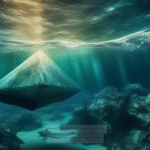What Does the Latest Sonar Technology Reveal About the Loch Ness Monster?
What Does the Latest Sonar Technology Reveal About the Loch Ness Monster?
The Loch Ness Monster, often affectionately referred to as “Nessie,” has captivated the imaginations of people worldwide for decades. From its first reported sighting in the 6th century to the modern day, this enigmatic creature has been the subject of countless investigations, theories, and tales. As technology evolves, so too do the methods used in the quest to uncover the truth about this elusive being. Recently, advancements in sonar technology have provided new insights into the depths of Loch Ness, raising the question: What does the latest sonar technology reveal about the Loch Ness Monster? In this post, we will explore the historical context, core concepts, evidence, and alternative perspectives surrounding this ongoing mystery.
Historical Context of the Loch Ness Monster
The legend of the Loch Ness Monster dates back to ancient times. The earliest account of a creature in Loch Ness comes from the Life of St. Columba, written in 565 AD, where it is said that Columba encountered a “water beast” that attacked a man. This account set the stage for centuries of speculation and sightings. The modern era of Nessie sightings began in the 1930s when the infamous “Surgeon’s Photo” emerged, purportedly showing a large creature in the loch. While this photo was later revealed to be a hoax, it sparked a renewed interest in Loch Ness and led to numerous investigations, including the use of sonar technology.
Core Concepts: Understanding Sonar Technology
Sonar, which stands for Sound Navigation and Ranging, is a technology that uses sound waves to detect and locate objects underwater. It works by emitting sound pulses and measuring the time it takes for them to bounce back after hitting an object. There are two primary types of sonar: active and passive. Active sonar sends out sound waves, while passive sonar listens for sounds made by objects in the water. In the context of Loch Ness, sonar technology has been employed to map the loch’s depths and search for evidence of large aquatic creatures.
Recent Sonar Expeditions at Loch Ness
In recent years, several sonar expeditions have been launched to seek evidence of Nessie. Notably, the 2019 Loch Ness Project utilized advanced sonar equipment to conduct a comprehensive survey of the loch. This expedition employed a multi-beam sonar system capable of capturing detailed images of the underwater landscape. Researchers scanned over 240 square kilometers of the loch, resulting in thousands of sonar readings. The aim was to detect any anomalies that could indicate the presence of a large creature.
Findings and Anomalies: What Did the Sonar Reveal?
The 2019 sonar survey yielded intriguing results. While researchers did not find definitive evidence of the Loch Ness Monster, they did uncover several anomalies that sparked further investigation. Among these were unidentified objects that appeared on sonar readings, which did not match the characteristics of known fish or submerged debris. Some of these anomalies were significant in size, leading to speculation about their origin. Researchers noted that while the sonar data was inconclusive, it reignited interest in the possibility that something extraordinary could be lurking beneath the surface.
Comparative Analysis: Loch Ness vs. Other Cryptids
When considering the Loch Ness Monster, it’s useful to compare it with other well-known cryptids, such as Bigfoot or the Chupacabra. Each of these creatures has been the subject of extensive folklore and investigation, yet they differ significantly in terms of evidence and sightings. For instance, while Bigfoot is often associated with land-based sightings and footprints, Nessie’s existence is tied to a specific body of water. The differences in habitat present unique challenges for investigation and evidence gathering.
| Cryptid | Habitat | Typical Evidence | Notable Sightings |
|---|---|---|---|
| Loch Ness Monster | Freshwater loch | Sonar readings, photographs | Surgeon’s Photo, 1930s sightings |
| Bigfoot | Forests | Footprints, hair samples | Various sightings across North America |
| Chupacabra | Various | Animal carcasses, eyewitness accounts | Reports from Puerto Rico and the Americas |
Practical Implications: What Does This Mean for Cryptozoology?
The use of sonar technology in the investigation of the Loch Ness Monster has significant implications for the field of cryptozoology. It demonstrates how advancements in technology can enhance our understanding of unexplained phenomena. Sonar expeditions can help identify large marine life and provide data that may lead to discoveries of new species. Furthermore, these investigations can foster a scientific approach to cryptozoology, promoting rigorous methodologies over anecdotal evidence.
Alternative Perspectives: Skepticism vs. Belief
The Loch Ness Monster has both fervent believers and staunch skeptics. Skeptics argue that there is insufficient evidence to support the existence of such a creature. They often cite the lack of physical remains or verifiable sightings as reasons for disbelief. Conversely, believers point to the creature’s longevity in folklore and the numerous unexplained sightings as compelling reasons to keep searching. This divide highlights the complex interplay between science, belief, and the human desire to explore the unknown.
Common Misconceptions about the Loch Ness Monster
One common misconception is that the Loch Ness Monster is simply a prehistoric dinosaur, such as a plesiosaur. While this idea is popular in media and culture, there is no scientific evidence to support this claim. Additionally, many people believe that every sonar reading must signify a large creature, ignoring the fact that sonar can pick up a variety of objects, including schools of fish or natural underwater formations. Understanding these misconceptions is crucial for maintaining a balanced perspective on the Loch Ness phenomenon.
Key Insight: The Loch Ness Monster remains a mystery partly because of the widespread misconceptions surrounding it. Critical thinking and scientific inquiry are essential for unraveling the truth.
Best Practices for Investigating Cryptids
For those interested in investigating cryptids like the Loch Ness Monster, it is essential to adopt a scientific approach. Here are some best practices:
- Utilize advanced technology: Employ sonar, drones, and underwater cameras for more comprehensive investigations.
- Collaborate with experts: Work with marine biologists and zoologists to analyze findings accurately.
- Document evidence rigorously: Keep detailed records of sightings, sonar readings, and environmental conditions.
- Promote skepticism: Approach investigations with an open mind, but remain critical of the evidence.
Future Developments: Ongoing Research and Exploration
As technology continues to advance, the possibilities for uncovering the truth about the Loch Ness Monster grow. Future expeditions may incorporate even more sophisticated sonar technology, artificial intelligence for data analysis, and collaborative efforts with marine research institutions. The Loch Ness Project and similar organizations remain committed to ongoing research, demonstrating that the quest for Nessie is far from over.
Conclusion
The quest to uncover the truth about the Loch Ness Monster continues to intrigue both believers and skeptics alike. Recent sonar expeditions have provided fascinating insights, revealing anomalies that challenge our understanding of Loch Ness’s depths. While definitive evidence of Nessie’s existence remains elusive, advancements in technology offer hope for future discoveries. By embracing a scientific approach and fostering critical inquiry, we can continue to explore this enduring mystery. As we move forward, the Loch Ness Monster will undoubtedly remain a symbol of humanity’s fascination with the unknown, reminding us that some mysteries are worth pursuing, even in the face of uncertainty. 🐉💡
Other Articles
What Happened to the Advanced Civilization of the Indus Valley?
Recent Posts
- What Happened to Flight MH370? The Conspiracy Theories That Still Haunt Us
- What Secrets Lurk Within the Walls of the Infamous Trans-Allegheny Lunatic Asylum?
- What Evidence Supports the Existence of Bigfoot in the Pacific Northwest?
- What Happened to the Indus Valley Civilization? Unraveling the Mysteries of Ancient Urban Life
- Can Telepathy Be Scientifically Proven Through Laboratory Evidence?







